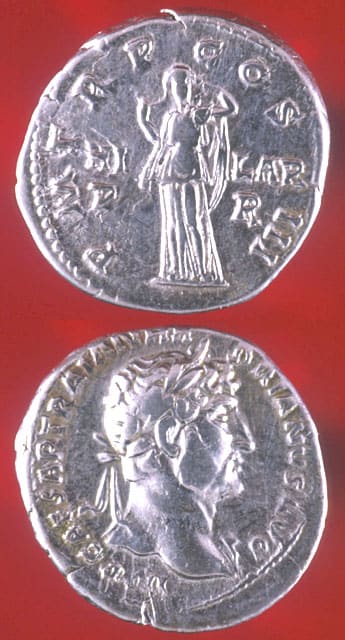Silver Denarius of Emperor Hadrian, 117 CE - 138 CE
Silver
C.0654
Impressive silver Denarius dating to the reign of Hadrian. This is a rare variant. It has not been possible to find a precise match, although it is likely to have...
Impressive silver Denarius dating to the reign of Hadrian.
This is a rare variant. It has not been possible to find a precise match, although it is likely to have been struck in Rome. The profile of Hadrian is closest match to a variant from 119-122. While minted in Rome, it was found in Palestine.
Obverse: IMP CAESAR TRAIAN HADRIANVS AVG. Bust of the Emperor Crowned in a Laurel Wreath.
Reverse: PM TR P COS III/HILAR P R. Hilaritas Standing Facing Forwards, Lifting her Veil.
Hilaritas is the female personification of Rejoicing. She is normally draped and holds either one or two long palm-branches. Other common attributes include a cornucopia, a sceptre or a patera (dish). She is sometimes accompanied by children. Hilaritas is never a common subject on coins, but appear from the time of Hadrian until the late 3rd century AD.
Publius Aelius Hadrianus, better known as Hadrian, was born in Spain in 76 AD and died in 138 AD. He ruled the Roman Empire from 117 to 138, during which time the Empire reached its apotheosis. Being the third of the so called Five Good Emperors, his rule was characterised by comparatively humanitarianism and conservatism. Following a political career of some distinction – he served as prefect, legate, consul, tribune and senator – it was his expedition to Parthia with Trajan led to his greatest success; Trajan became seriously ill and died on the way back to Rome, naming Hadrian as successor. Hadrian purged the senate of opposition upon his return to Rome, and set about a somewhat conservative reign that involved strengthening the empire’s boundaries and the surrender of indefensible areas (i.e. Mesopotamia). He was known more for rule by threat and strength than active military conquest.
Personally, he was well educated and fond of the great Greek writers and philosophers, and was even appointed Archon in Athens. He was a great patron of the arts, including landscaping and architecture: under his reign the Pantheon was rebuilt, as well as many libraries, aqueducts, libraries and theatres. He was also a keen poet, an Epicurean philosopher and a huntsman, commissioning various reliefs showing him killing bears, lions etc. He is also notable for introducing the socially-acceptable beard – all other emperors before him had been clean shaven. The great love of his life was a boy named Antinous, which may explain the lack of natural heirs to Hadrian’s lineage. Antinous drowned in the Nile aged about 19; the mourning Hadrian had him deified.
This is a striking and attractive ancient coin from the rule of a remarkable ruler.
This is a rare variant. It has not been possible to find a precise match, although it is likely to have been struck in Rome. The profile of Hadrian is closest match to a variant from 119-122. While minted in Rome, it was found in Palestine.
Obverse: IMP CAESAR TRAIAN HADRIANVS AVG. Bust of the Emperor Crowned in a Laurel Wreath.
Reverse: PM TR P COS III/HILAR P R. Hilaritas Standing Facing Forwards, Lifting her Veil.
Hilaritas is the female personification of Rejoicing. She is normally draped and holds either one or two long palm-branches. Other common attributes include a cornucopia, a sceptre or a patera (dish). She is sometimes accompanied by children. Hilaritas is never a common subject on coins, but appear from the time of Hadrian until the late 3rd century AD.
Publius Aelius Hadrianus, better known as Hadrian, was born in Spain in 76 AD and died in 138 AD. He ruled the Roman Empire from 117 to 138, during which time the Empire reached its apotheosis. Being the third of the so called Five Good Emperors, his rule was characterised by comparatively humanitarianism and conservatism. Following a political career of some distinction – he served as prefect, legate, consul, tribune and senator – it was his expedition to Parthia with Trajan led to his greatest success; Trajan became seriously ill and died on the way back to Rome, naming Hadrian as successor. Hadrian purged the senate of opposition upon his return to Rome, and set about a somewhat conservative reign that involved strengthening the empire’s boundaries and the surrender of indefensible areas (i.e. Mesopotamia). He was known more for rule by threat and strength than active military conquest.
Personally, he was well educated and fond of the great Greek writers and philosophers, and was even appointed Archon in Athens. He was a great patron of the arts, including landscaping and architecture: under his reign the Pantheon was rebuilt, as well as many libraries, aqueducts, libraries and theatres. He was also a keen poet, an Epicurean philosopher and a huntsman, commissioning various reliefs showing him killing bears, lions etc. He is also notable for introducing the socially-acceptable beard – all other emperors before him had been clean shaven. The great love of his life was a boy named Antinous, which may explain the lack of natural heirs to Hadrian’s lineage. Antinous drowned in the Nile aged about 19; the mourning Hadrian had him deified.
This is a striking and attractive ancient coin from the rule of a remarkable ruler.
